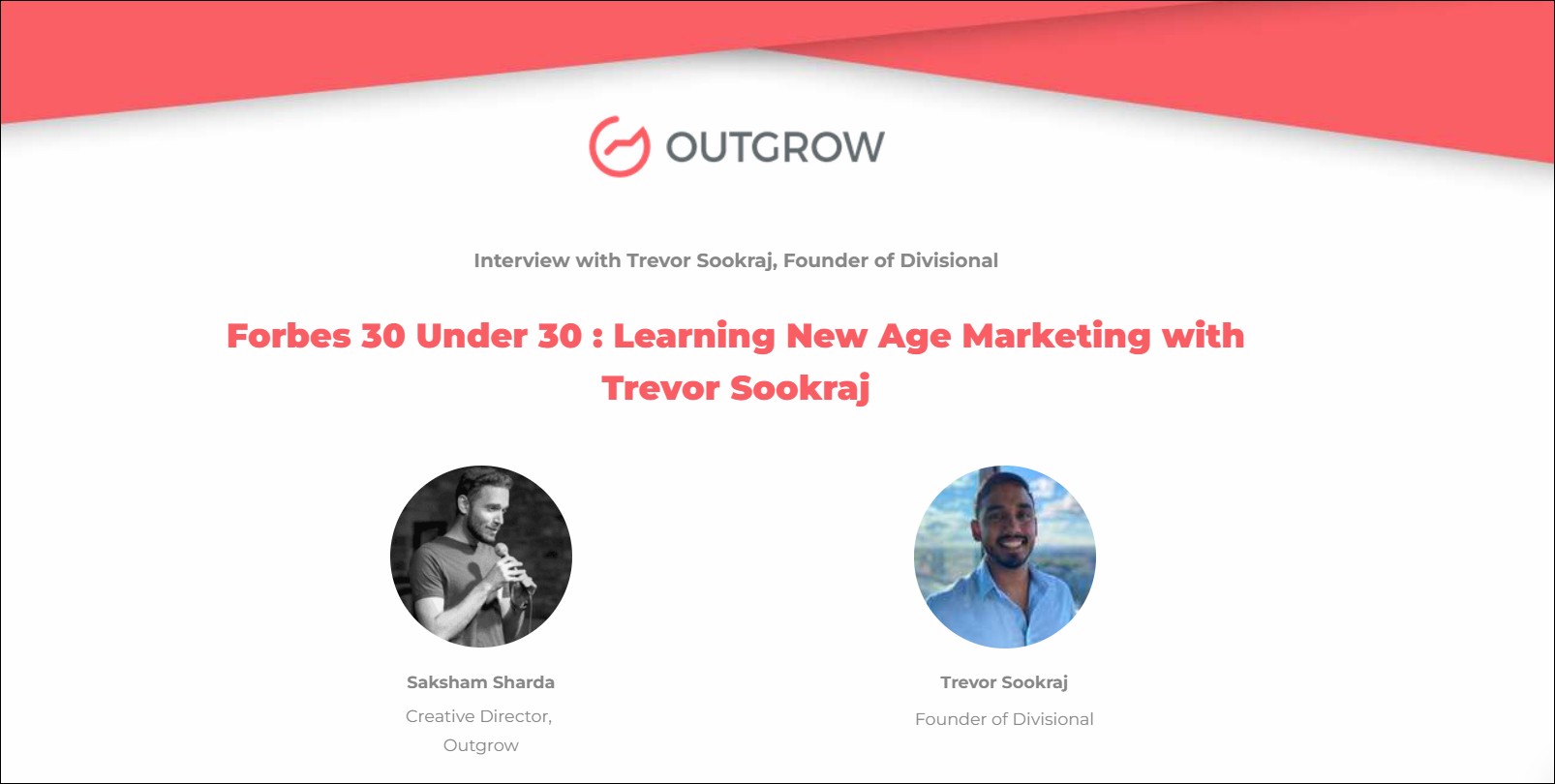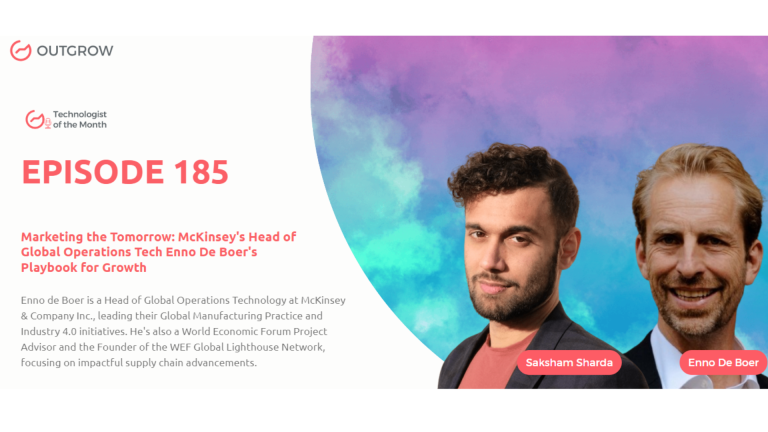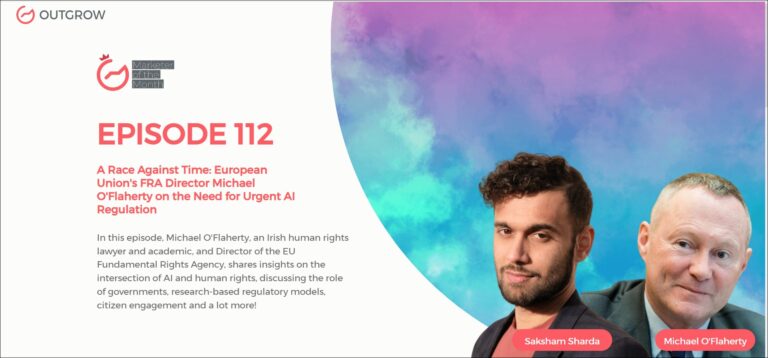Hey there! Welcome to the Marketer Of The Month blog!

We recently interviewed Trevor Sookraj for our monthly podcast – ‘Marketer of the Month’! We had some amazing insightful conversations with Trevor and here’s what we discussed about –
1. Growth Experimentation for B2B Startups in a post-pandemic world
2. How to ensure consistent sales and marketing alignment
3. Layering automation tools like LinkedIn Automation to increase response rates
4. How exhibiting a genuine interest in the consumer can work wonders
5. How Divisional helped Samba TV reach their 30-million Series A
6. Understanding when to hire internally and when to outsource
About our host:
Dr. Saksham Sharda is the Chief Information Officer at Outgrow.co. He specializes in data collection, analysis, filtering, and transfer by the means of widgets and applets. Interactive, cultural, and trending widgets designed by him have been featured on TrendHunter, Alibaba, ProductHunt, New York Marketing Association, FactoryBerlin, Digimarcon Silicon Valley, and at The European Affiliate Summit.
About our guest:
Trevor Sookraj is the Founder of Divisional – a marketer-first agency that addresses the problem of loss of equity for early-stage startups when hiring an in-house marketer by providing them a full growth team of Divisional employees at a fraction of the conventional cost. His outsourcing approach has helped numerous Seed and Series-A B2B SaaS startups, with revenue growing 240% this year to $1.5 million.
Forbes 30 Under 30: Learning New Age Marketing With Trevor Sookraj
Table of Contents
The Intro!
Trevor Sookraj: Hi, I’m Trevor Sookraj! I’m on this year’s Forbes 30 under 30 lists for marketing and advertising, and I’m here to give you my free tips about running a business in the upcoming roaring 20s.
Don’t have time to read? No problem, just watch the Podcast!
Or you can just listen to it on Spotify!
The Rapid Fire Round!

Saksham Sharda: At what age do you want to retire?
Trevor Sookraj: 60.
Saksham Sharda: How long does it take you to get ready in the mornings?
Trevor Sookraj: Probably at least an hour, an hour and a half. I’m not very much of a morning person.
Saksham Sharda: Most embarrassing moment of your life?
Trevor Sookraj: Falling over in the chairlift line
Saksham Sharda: Fill in the blank: An upcoming Marketing trend is _________.
Trevor Sookraj: An upcoming marketing trend is Automating, Twitter outreach, and engagement.
Saksham Sharda: The city in which the best kiss of your life happened?
Trevor Sookraj: Guelph, Ontario.
Saksham Sharda: Pick one: Mark Zuckerberg or Jack Dorsey?
Trevor Sookraj: Jack Dorsey
Saksham Sharda: The first movie that comes to your mind when I say the word ‘ambition’?
Trevor Sookraj: Limitless.
Saksham Sharda: When did you last cry and why?
Trevor Sookraj: Talking to my therapist, and reliving life experiences are good, but not always fun.
Saksham Sharda: How do you relax?
Trevor Sookraj: Playing FIFA gospers.
Saksham Sharda: How do you pronounce “GIF”?
Trevor Sookraj: Definitely “GIF”.
Saksham Sharda: What is the dumbest thing you’ve seen on social media?
Trevor Sookraj: Raw meat experiment on Instagram. Pretty dumb, but can say I’m not impressed.
Saksham Sharda: How many cups of coffee do you drink per day?
Trevor Sookraj: I’ll say I hover around two to three.
Saksham Sharda: A habit of yours that you hate?
Trevor Sookraj: I go to the office way too much for my good.
Saksham Sharda: The most valuable skill you’ve learned in life?
Trevor Sookraj: Active listening.
Saksham Sharda: Your Favorite TV Show?
Trevor Sookraj: Definitely “The Office”.
The Big Questions!

Saksham Sharda: How should B2B SaaS startups go about growth experimentation in the coming post-pandemic decade?
Trevor Sookraj: So B2B SaaS startups should have a bias for product marketing and knowing their customer is the basis for any type of growth experimentation that you’d want to run. You have to remember that at the early stage, from your first 10 customers to your next 40 customers, that’s 100 customers, all of those are going to impact how your product grows, how you build out your sales team, and try to convert initial signups into paying customers. A lot of this growth experimentation is key to the kind of information what that looks like. If there’s no consistency or repeatability between the customers you’re acquiring, you won’t be able to scale up predictably. And that’s one of the biggest misses for companies that are trying to hit higher levels of revenue and funding. Focus on first identifying the assumptions about your customers. So what do you think they care about and their pain to buy, you can usually do this by talking to your existing pilot customers, doing customer research, and kind of understanding how they talk about their lives and their challenges. Then you’re going to want to map those two hypotheses. So why your product solves the pain points and problems that those customers think they have? And specifically, the role your product kind of plays with that as a hypothesis. And then that’s how you’re going to map that into actual tests and experiments based on where those customers exist. So if you know that these customers are likely to be online in certain areas, and you want to be able to test whether your hypothesis is correct about the product, you can then kind of create some of those experiments and have very clear benchmarks on what you want to hit to make it successful. To give you an example, if I know that I’m trying to go in front of maybe like its engineers, on a specific platform like Google search or something based on knowing they have a certain pain point and having my product appear there is going to be relevant, maybe I’m trying to target at 20% conversion rates, on getting a click to form submission with a 100 clicks or click to a free trial. If it’s maybe targeting, you know, maybe it’s a construction foreman. And in the strategic industry, I’m doing outbound emails. Maybe I want to have at least 200 people in that segment where I can say, let’s get between 1.5% and 3% response rate to be successful. And that’s going to pan out to X number of demos that will be qualified. So those are all things that I would say are important when you’re facilitating some of the experiments. As your company scales, you want to keep that experimentation, what we call the 70-20- 10 rule. So 70% of your budget is spent on things that you know work and are repeatable parts of your engine. 20% are on ongoing tests, typically stuff you’ve already tried but maybe you’re not at that stage or have enough information to decide on. And then 10% of that budget on net new tests if you have hunches or high conviction behind no matter what scale your company is, whether it’s a seed stage company to a public company like Samsara or Shopify, it’s important to have that expert growth experimentation and testing framework in play. Because you continuously learn more about your customers, what works, what doesn’t, and you’re never just you know, sitting stagnantly as a regular marketer.
Saksham Sharda: What steps should be taken to ensure a seamless sales and marketing alignment?
Trevor Sookraj: Sales and Marketing alignment is such a good question and it’s so crucial for any organization that’s trying to scale. Often I’ve seen that a bigger organization involves a lot of finger-pointing. So the sales team will look to the marketing and say you’re giving us bad leads when they’re not converting. Whereas the marketing team looks at the sales team and says you’re not working them properly. And that’s why they’re not converting into actual customers. So it’s a lot of back and forth. And it can be a pretty touchy relationship for a lot of organizations. That’s why when you start your growth organization at a company and try to build that out, you have to make sure you get that sales buy-in as a marketer. So that means looking at your existing customers and understanding why they bought before what were their main objections? Who was qualified but wasn’t ready for a sales conversation and not ready to buy? And if so, like, how can we nurture those types of leads, and how to get outcomes in the future and make sure they stay warm? So those are all things that you know, taking an active interest in how salespeople do their job, not making assumptions, and trying to learn from them can be super helpful to getting that strong relationship from day one, practically as far as getting alignment, especially if you’re working in an organization that is largely sales lead coming on as a head of growth and marketing, you need to figure out what is sales doing currently, and how can it be amplified or augmented with growth marketing. So for example, a lot of sales teams work with what will be called personal email. So they have their name at the company’s, you know, core domain.com. But they’re not working with what we call the Werner domain. So if you’re working at doing a cold outbound email to different lists, you want to make sure you’re using new domains that are warmed up and ready for outreach. That way, if you get flagged as spam or anything happens, it doesn’t ruin the core experience for the product. So if you can warm up those new domains as a marketer and show how you get increased engagement rates and other tactics. But by doing that, in comparison to the original efforts, you’re probably gonna get more buy-in from sales. Likewise, like if they’re doing you know, outbound email solely, maybe you want to layer in LinkedIn automation, or things that, you know, via LinkedIn helper or phantom Buster or other tools that can show value for them. Because if you can do that, maybe you might increase their response rates from 3% to 5%, and 6% percent, and there have more appetite to say, Well, maybe you can then add cloud cover ads on certain platforms in front of their accounts, they want to go after other ideas, they’ll also be probably more likely to participate in marketing material, other areas that you need help with to be able to make a better case for cold leads that are coming in through the door. One of the examples that come to mind here for a company that loved working with is Samba TV, they’re in the mar-tech space. And we’re working as their, you know, the facto growth team helping them to expand to new channels and test products and new verticals, they have a pretty large sales force, as far as actual, you know, reps that are selling the product, but a relatively small, you know, growth dimension team. And we were very powerful when you look at lead quality sales cycles, and how prospects engage with them post form submission, especially when you’re selling a product that is not an overnight sale. And it’s typically in an enterprise or, you know, Account Based Marketing type approach. So as long as you can make sure you take a serious interest in how sales are operating, and not just operate as demand generation and operate as full funnel growth, that’s usually a big win for getting sales and marketing alignment at any organization.
Saksham Sharda: Could you talk about a couple of case studies where your strategies have borne fruit?
Trevor Sookraj: Tried a lot of strategies for different companies. And I’ll preface this by saying that a lot of these are just specific to the company that you work with. And it’s usually about taking a serious interest in the customer, the full funnel of the experience, and then coming up with ideas that are offsets of that as opposed to finding, you know, hacks or strategies that might work in certain scenarios. But hopefully, this is helpful from a sharing perspective. So the first company that came to mind that worked with called Live Control was playing in the kind of hardware-software space for recording and streaming events that typically happened a lot during the pandemic, like, you know, funerals or church services, that’s the thing. They’re an LA-based company they receive state, then they came on to work with us, and the founder was managing growth himself along with, you know, various agencies and realized it just wasn’t sustainable. So they brought on divisional, to weed out their growth and run channel experiments and analytics and tracking and go on with the sales team. And a lot of what we did in the earlier days was looking at how they’re different prospects that high volumes were interacting with their pages, and kind of what the experience was for the sales reps, once they converted to a call, one thing we realized was, there was a lot of education that had to happen with this product. So it wasn’t as easy as just driving someone to a landing page and then telling them like a book, a demo call that works via type form, we realize that a lot of the education should happen before they get on the call. So one of the things that we subbed out was using this product called Video Ask instead of the type where I was run by site forum, where you can offer customized videos for people that are clicking on certain answers in a form submission process, and then get a video relevant to that. So it’s almost answering their responses and concerns based on what’s happening from that. And it worked out well. They raised a 30 min series in May 2021 and hired someone directly from our team to weed out growth for them full-time. So that was a great outcome that kind of came from just taking an interest in the customer and seeing like from a conversion rate and sales enablement perspective, like what it looks like a full funnel. Another company that comes to mind here, is this company called boutique which works with your can-see E-commerce Saas company that helps businesses who typically have a store-in-person presence to connect with online visitors. So initially, we’re testing a lot of broad audiences with e-commerce stores like Shopify customers and just seeing what kind of resonated and a lot of it responses were you know, this is interesting from customers but or from prospects but they weren’t converting into customers, I realized that it was about having specific pains are related to what boutique solves. So certain companies had those pains, which is to figure out how to identify those types of companies. We realized that there were companies that were using, like Zoom and Calendly to book those types of meetings with in-store reps and doing like an online session. And that was a real pain point because it wasn’t very effective. So we actually built out a targeted list using those prospects and got a much higher demo conversion rate, even in the range of like eight to ten demos, qualified demos a month, just the outbound email, by running that at more targeted segments. So thinking again, about the customer and what they experienced, that was a great outcome for them. The last one that comes to mind is this company called Quickly. They’re a construction tech company that started as a boundless venture studio, they built a platform that allows people to rent equipment online. So we’re testing a lot of their verticals using search engine marketing via Google ads and wanting to figure out how we can see which ones had the most amount of salience where they should kind of build their product around. So we built landers for equipment rental, heavy equipment, rental, like cranes, etc, Party Rentals, like, you know, tents and those kinds of pieces and other offshoots of that and realize that certain verticals had other higher conversion rates into the actual customer demo funnel, and looking not just like what the cost per form submission was in-depth books demo, but actually what the customer acquisition cost was on larger sample size. So in the last year, we drove about 90% of their inbound volumes using some of those tactics and helped them to hire an account executive to handle that demand and kind of get additional capital to drive greater success for them. But that was another example of having specific strategies, again, that is kind of based on testing hypotheses or assumptions about your customer. And using that to kind of drive some of the big growth wins they got in the last year.
Saksham Sharda: When should I hire an agency/freelancer or a full-time hire?
Trevor Sookraj: So a popular question I get a lot is when do I use an agency or freelancer? And when do I use it to make a full-time hire for my business? This comes up almost, I would say at the seed stage where you’re looking at founders who have capital, have a small team, largely product and engineering, and are trying to think about how can I build out my sales and growth funnel to be able to drive demand and scale my product, and there, you know, part-time talents, probably the best way to do that without making big commitments. The big commitment problem is large because full-time hires take a while to find, we’ve seen that it takes anywhere from three to six months to find a good head of growth hire that fits your culture, aligns with your team, and they’ll come in and hit the ground running. So recruiting isn’t easy not to mention the amount of time it takes founders to interview candidates and figure out who’s a good fit at that stage, which again, is not the best use of their time, given that they’re running the company, along with equity and ownership, you have to give them so all these things kind of climax and saying how can we offer you know agencies or part-time resources for a better Avenue or outcome for some of these startups, agencies are really good when you have transactional needs. So if you’re creating a video for a specific purpose, you need an animation, that’s a great use case, if you’re doing a web redesign that has very specific outcomes, that could be a good use case. That’s where agencies, I would say, come in useful and can be a big help. And that’s because most agencies are verticalized, they focus on specific channels or aspects of your growth, whether it’s design, search engine marketing, email marketing, content, SEO, etc. All those are areas that are likely to be pretty transactional if you know what you need. And it’s most popular, I would say when you scale and certainly your product market fit because that’s exactly when you know exactly what you need to do, you just need help doing it. Because your team is pretty strapped for resources. So for example, if you have a clear audience and clear messaging, and you’ve had repeatability on acquiring customers with that type of pitch, maybe you do have to hire a paid ads agency to take over your channel optimization and run them, run consistent refreshes and keep things optimized there. Because they’re not doing a ton of net new things to drive the results or you know, new tests that you want to do. And if you have those ideas, you can probably quarterback them for an agency because it’s pretty outsourced. Whereas if you’re unsure about those, you know, clear audiences repeatability in your customers, those pieces, outsourcing to an agency or freelancer can be a major issue, because you won’t have visibility into why things aren’t working. And you will assume that it’s probably the two of its problems. But in a lot of cases, they’re not built to handle that type of ambiguity and full-funnel growth that you need from a full-time hire. And that’s usually why I recommend you go and go into the full-time hire route working with a company or an individual species that can kind of plug into your org. And that’s a lot of what we do in a division that has built growth teams for companies that have that head of new the head of growth and growth marketing manager higher. So they’re able to have that effect of being plugged into their organization, looking full funnel not just at the demand generation, but also the product sales, customer success, etc. which you won’t get again with a lot of agencies that are strictly focused on specific aspects of the product. But we also see that there’s a lot of value in the more transactional engagement of agencies where it doesn’t make sense to hire someone on a short term engagement full-time with your company. And also when it makes sense to have someone owning it if it’s just a very transactional activity.
Let’s Conclude!
Saksham Sharda: Thanks everyone for joining us for this month’s episode of Outgrow’s Marketer of the Month. That was Trevor Sookraj, who is the Founder of Divisional. Thanks for joining us, Trevor.
Trevor Sookraj: Thanks for having me.
Saksham Sharda: Check out the website for more details and we’ll see you once again next month with another marketer of the month.



